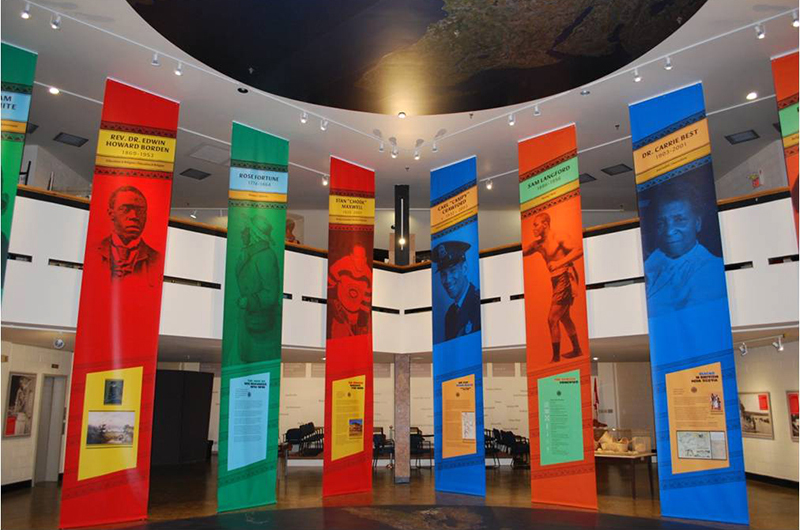Established by the Society for the Protection and Preservation of Black Culture in Nova Scotia in 1983, the Black Cultural Centre for Nova Scotia is located at 10 Cherry Brook Road in Cherry Brook, Nova Scotia. Its location is purposeful, as Cherry Brook is the oldest Black community in the metropolitan municipality of Halifax.
The purpose of the center, as per its website, is “to protect, preserve and promote the history and culture of African Nova Scotians” and to serve as “… a museum and cultural gathering place, where the rich history of Nova Scotians of African descent can be discovered and explored.”
The concept for the center was initially proposed by Reverend Dr. William Pearly Oliver in 1972. With its creation, he hoped that it would supplement what Black communities in Nova Scotia lacked and support their further development. The Society for the Protection and Preservation of Black Culture in Nova Scotia, known simply as the Black Cultural Society, was incorporated in 1977. Designated as a charitable organization, the Black Cultural Society is comprised of twenty-seven members; one member who represents the African United Baptist Association; the remaining members represent the Black communities of Nova Scotia.
In the spring of 1982, ground was broken and by late summer of 1983, the Black Cultural Centre for Nova Scotia was opened to the public.
The Centre covers topics such as community creation, migration, slavery, religion and refugeeism as well as groups of people, including the Loyalists, the Maroons and Caribbean migrants. Discussion of Blacks enlisted in the military, specifically the No 2 Construction Battalion, is also presented.
It also houses a permanent exhibit on Africville, one of the earliest communities of free Blacks. It was a community founded by Black Nova Scotians, many of who were Black Loyalists who had been given their emancipation by England during the American Revolution and the War of 1812. Having been formerly enslaved, these early settlers lived on the southern shore of Bedford Basin in Halifax. Its name. “Africville”, was given because of the indirect ancestry of its residents, not that they directly descended from the continent of Africa.
The Black Nova Scotian residents of Africville would reside there, despite intentional government neglect and abuse, from the 1800s to the 1960s. During this time, Halifax refused to implement standard infrastructure services such as creation and sustainment of schools; as well as maintenance of buildings, paved roads, clean water and safe sewage removal. In fact, in 1958, it introduced a waste-treatment facility near Africville. As a result of the purposely-intended neglect and sabotage of the government, the residents have suffered immensely in poverty, which include greatly diminished health and despairing living conditions. Halifax condemned the community in the late 1960s, forcing many residents to move into newer, but still substandard, housing. Ironically, the area was needed to develop a bridge that accompanied highway construction and port facilities. The government also changed the name from “Africville” to “Seaview Memorial Park” and the area became used primarily as an off-leash dog park.
Since the 1970s, the Africville residents who have remained living in the small community have done so in protest to preserve their Black Nova Scotian cultural identity and heritage and to combat systemic racism. In 1996, Africville was designated a National Historic Site of Canada and became a symbol for Black Canadians to preserve their unique communities, cultures and institutions. In 2010, the Halifax Council, led by Mayor Peter Kelly, issued an official apology, the “Africville Apology”, to the community. Also, in a 4.5 million-dollar compensation deal with the federal government, Halifax agreed to compensate descendants and their families who had been evicted. Those who have remained in Africville have filed civil lawsuits for compensation for their property. Finally, the name of Africville was restored as the name of the community.
Also, in 2010, the Halifax Council and the Government of Canada created the Africville Heritage Trust. With $250,000, the trust was established to design and construct a replica of Seaview African United Baptist Church, the church that historically served the community. This site, which would serve as a museum and interpretive center, was built and opened to the public in 2011. Africville is presently a memorial site.
Aside from the permanent exhibits and displays, there are temporary shows in their exhibit rooms. The museum hosts concerts and artistic performances in its auditorium, which seats up to 225 guests. The Centre may be rented for an event or occasion. Additionally, there are three meeting rooms (ranging from 15-person capacity, a 20-person capacity and a 30-person capacity); rooms may be used for a small group setting or even to receive guests in preparation for an event held in the auditorium.
The staff conducts educational outreach in the form of guided tours, lectures and professional workshops. Its outreach extends beyond the Center, as they are also active in cultural events held throughout the province. As part of its development, the Centre also allows for artifacts; images; primary and secondary documents; and personal accounts to be submitted for their consideration.
The Centre is open Monday through Friday, from 9:30 am to 4:30 pm; it is only open on Saturday, from 12pm to 4 pm during the months of June through September. Onsite, visitors may conduct research on interests of Black culture in the Library, whose archival materials may be traced back to the 1600s. Although there is limited accessibility, the site is wheelchair accessible. It may be visited via public transportation but if traveling by a vehicle, there is parking available. Outside the facility, there are picnic tables at which to sit and eat. Additionally, items, including books, t-shirts, pens, coffee mugs, umbrellas, key chains and DVDs, to commemorate your visit to the Black Cultural Centre for Nova Scotia may be purchased at its gift shop.
